Apple Announces 5nm A14 SoC - Meagre Upgrades, Or Just Less Power Hungry?
by Andrei Frumusanu on September 15, 2020 4:30 PM EST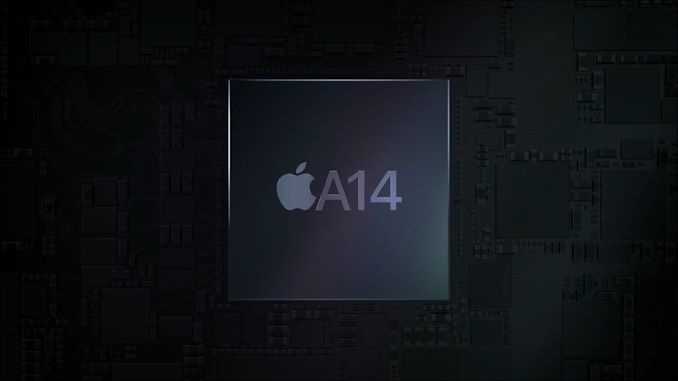
Amongst the new iPad and Watch devices released today, Apple made news in releasing the new A14 SoC chip. Apple’s newest generation silicon design is noteworthy in that is the industry’s first commercial chip to be manufactured on a 5nm process node, marking this the first of a new generation of designs that are expected to significantly push the envelope in the semiconductor space.
Apple’s event disclosures this year were a bit confusing as the company was comparing the new A14 metrics against the A12, given that’s what the previous generation iPad Air had been using until now – we’ll need to add some proper context behind the figures to extrapolate what this means.
On the CPU side of things, Apple is using new generation large performance cores as well as new small power efficient cores, but remains in a 2+4 configuration. Apple here claims a 40% performance boost on the part of the CPUs, although the company doesn’t specify exactly what this metric refers to – is it single-threaded performance? Is it multi-threaded performance? Is it for the large or the small cores?
What we do know though is that it’s in reference to the A12 chipset, and the A13 already had claimed a 20% boost over that generation. Simple arithmetic thus dictates that the A14 would be roughly 16% faster than the A13 if Apple’s performance metric measurements are consistent between generations.
On the GPU side, we also see a similar calculation as Apple claims a 30% performance boost compared to the A12 generation thanks to the new 4-core GPU in the A14. Normalising this against the A13 this would mean only an 8.3% performance boost which is actually quite meagre.
In other areas, Apple is boasting more significant performance jumps such as the new 16-core neural engine which now sports up to 11TOPs inferencing throughput, which is over double the 5TOPs of the A12 and 83% more than the estimated 6TOPs of the A13 neural engine.
Apple does advertise a new image signal processor amongst new features of the SoC, but otherwise the performance metrics (aside from the neural engine) seem rather conservative given the fact that the new chip is boasting 11.8 billion transistors, a 38% generational increase over the A13’s 8.5bn figures.
The one explanation and theory I have is that Apple might have finally pulled back on their excessive peak power draw at the maximum performance states of the CPUs and GPUs, and thus peak performance wouldn’t have seen such a large jump this generation, but favour more sustainable thermal figures.
Apple’s A12 and A13 chips were large performance upgrades both on the side of the CPU and GPU, however one criticism I had made of the company’s designs is that they both increased the power draw beyond what was usually sustainable in a mobile thermal envelope. This meant that while the designs had amazing peak performance figures, the chips were unable to sustain them for prolonged periods beyond 2-3 minutes. Keeping that in mind, the devices throttled to performance levels that were still ahead of the competition, leaving Apple in a leadership position in terms of efficiency.
What speaks against such a theory is that Apple made no mention at all of concrete power or power efficiency improvements this generation, which is rather very unusual given they’ve traditionally always made a remark on this aspect of the new A-series designs.
We’ll just have to wait and see if this is indicative of the actual products not having improved in this regard, of it’s just an omission and side-effect of the new more streamlined presentation style of the event.
Whatever the performance and efficiency figures are, what Apple can boast about is having the industry’s first ever 5nm silicon design. The new TSMC-fabricated A14 thus represents the cutting-edge of semiconductor technology today, and Apple made sure to mention this during the presentation.
Related Reading:
- The Apple iPhone 11, 11 Pro & 11 Pro Max Review: Performance, Battery, & Camera Elevated
- The Samsung Galaxy S20+, S20 Ultra Exynos & Snapdragon Review: Megalomania Devices
- TSMC Expects 5nm to be 11% of 2020 Wafer Production (sub 16nm)
- ‘Better Yield on 5nm than 7nm’: TSMC Update on Defect Rates for N5


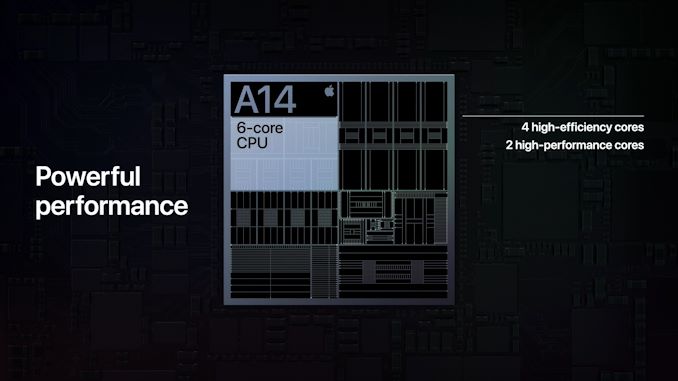
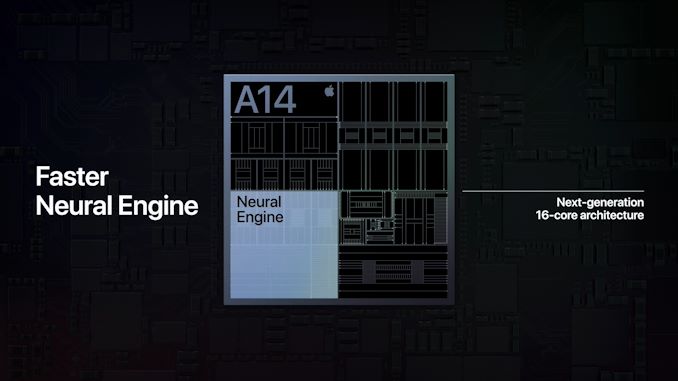
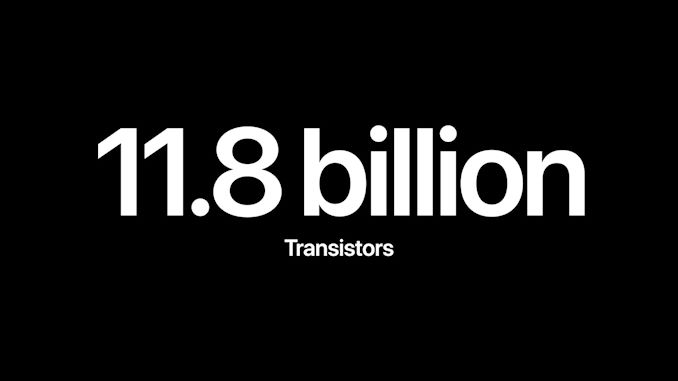
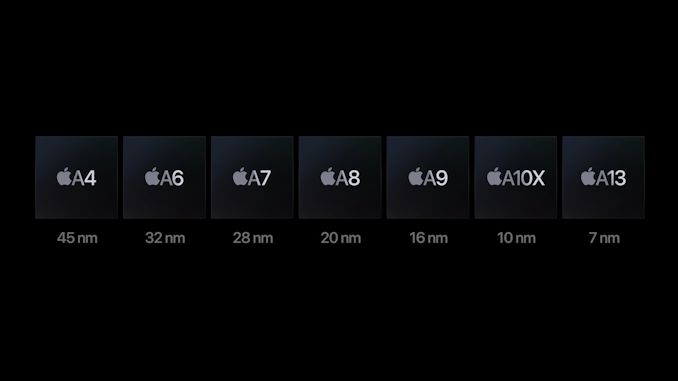








127 Comments
View All Comments
name99 - Tuesday, September 15, 2020 - link
Yes, but we still have no indication as to where they are actually USED.They certainly aren't visible in XCode. I have seen no indication that you can trigger their use via Accelerate calls. PERHAPS they are used by some CoreML calls?
My point is that when (if?) they're visible to 3rd party SW, that might boost the performance of some benchmarks, and general purpose code. (Or might not. It's hard to say when ALL you know is that they "accelerate matrix computation". Do they give us access to larger registers that could be used in alternate ways? Access to alternate cache use patterns? Access to some sort of permute or table lookup primitives?)
tipoo - Tuesday, September 15, 2020 - link
Afaik when you use CoreML, it automatically dispatches appropriate tasks to AMX, the neural engine, GPU, or CPU, depending on algorithm typename99 - Wednesday, September 16, 2020 - link
That AMX is included among the places to where CoreML dispatches is an ASSUMPTION.That's precisely my point -- I've seen nothing so far to indicate that the assumption is validated.
Apple has in the past shipped hardware (eg h.265) that wasn't activated until a year or so later, so this is not necessarily unprecedented.
tipoo - Monday, September 21, 2020 - link
It's not an assumption, I'm telling you forthright that AMX instructions are available in EL0, and are used by CoreML and Accelerate.framework.Tomatotech - Wednesday, September 16, 2020 - link
This seemed more of a consumer event - new watches, Apple Watch SE, iPad (the two cheaper models), new bands etc. Hence lighter on the nitty gritty of details on the chips etc. There wasn’t anything ‘Pro’ announced today, which is another reason for being light on details. Apple knows reviews will come out soon anyway.Nice to see Apple a (tiny) bit more of focus on value for money, shame it took a global pandemic to make them do so. They utterly dominate the high end in every sector they compete in so maybe this is a just a long planned move into the upper middle of the market. (Aided by the shift to Arm. Expect lots of technical detail when their ArmBooks come out.)
Speedfriend - Wednesday, September 16, 2020 - link
Focus on value for money? They put the price of the Air up by $100. Sure they kept the normal iPad the same price with a processor upgrade, but that is still a 2-3 year old processor in a 5 year old form factorname99 - Wednesday, September 16, 2020 - link
It's Apple. They're ALL consumer events! Apple is a consumer company!!!blackcrayon - Wednesday, September 16, 2020 - link
Kinda, but discussion the intricacies of optimizing your Swift code for METAL 2 isn't exactly consumer oriented (i.e. certain parts of WWDC).zaza - Tuesday, September 15, 2020 - link
AI features are probably used a lot for the iPhone's camera and LiDAR. But it seems that they are focusing on efficiency which is not a bad thing.nicolaim - Tuesday, September 15, 2020 - link
Typo: A14 SoC chip.SoC = System on a Chip